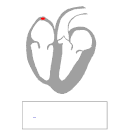Ventricular escape beat
Ventricular Escape Beat[edit]
A ventricular escape beat is a type of heart rhythm disturbance that occurs when the heart's normal pacemaker, the sinoatrial node, fails to initiate an impulse. This results in a backup pacemaker, typically located in the ventricles, taking over to maintain the heart's rhythm. Ventricular escape beats are a protective mechanism to prevent the heart from stopping entirely when the primary pacemaker fails.
Mechanism[edit]
Under normal circumstances, the sinoatrial node generates electrical impulses that travel through the heart, causing it to contract and pump blood. However, if the sinoatrial node fails to produce an impulse, or if the impulse is blocked, the heart's atrioventricular node or the ventricles themselves can generate an impulse. This impulse is known as a ventricular escape beat. The ventricles have an intrinsic rate of 20-40 beats per minute, which is slower than the normal heart rate.
Electrocardiogram (ECG) Characteristics[edit]
On an electrocardiogram (ECG), a ventricular escape beat is characterized by a wide and bizarre QRS complex, as the impulse originates in the ventricles rather than following the normal conduction pathway. The QRS complex is typically greater than 120 milliseconds. The absence of a preceding P wave is another distinguishing feature, as the impulse does not originate from the atria.

Clinical Significance[edit]
Ventricular escape beats are generally considered benign and are often seen in cases of bradycardia, where the heart rate is slower than normal. They can occur in healthy individuals, particularly during sleep, or in response to increased vagal tone. However, frequent ventricular escape beats may indicate underlying heart disease or electrolyte imbalances and warrant further investigation.
Management[edit]
In most cases, ventricular escape beats do not require treatment. However, if they are symptomatic or associated with significant bradycardia, treatment may involve addressing the underlying cause, such as correcting electrolyte imbalances or adjusting medications. In some cases, a pacemaker may be necessary to maintain an adequate heart rate.
Related Pages[edit]
References[edit]
- Goldberger, Ary L. "Clinical Electrocardiography: A Simplified Approach." Elsevier Health Sciences, 2017.
- Surawicz, Borys, and Timothy Knilans. "Chou's Electrocardiography in Clinical Practice: Adult and Pediatric." Elsevier Health Sciences, 2008.

-
Ventricular escape beat
-
Ventricular escape beat
Ad. Transform your life with W8MD's Budget GLP-1 injections from $75


W8MD offers a medical weight loss program to lose weight in Philadelphia. Our physician-supervised medical weight loss provides:
- Weight loss injections in NYC (generic and brand names):
- Zepbound / Mounjaro, Wegovy / Ozempic, Saxenda
- Most insurances accepted or discounted self-pay rates. We will obtain insurance prior authorizations if needed.
- Generic GLP1 weight loss injections from $75 for the starting dose.
- Also offer prescription weight loss medications including Phentermine, Qsymia, Diethylpropion, Contrave etc.
NYC weight loss doctor appointmentsNYC weight loss doctor appointments
Start your NYC weight loss journey today at our NYC medical weight loss and Philadelphia medical weight loss clinics.
- Call 718-946-5500 to lose weight in NYC or for medical weight loss in Philadelphia 215-676-2334.
- Tags:NYC medical weight loss, Philadelphia lose weight Zepbound NYC, Budget GLP1 weight loss injections, Wegovy Philadelphia, Wegovy NYC, Philadelphia medical weight loss, Brookly weight loss and Wegovy NYC
|
WikiMD's Wellness Encyclopedia |
| Let Food Be Thy Medicine Medicine Thy Food - Hippocrates |
Medical Disclaimer: WikiMD is not a substitute for professional medical advice. The information on WikiMD is provided as an information resource only, may be incorrect, outdated or misleading, and is not to be used or relied on for any diagnostic or treatment purposes. Please consult your health care provider before making any healthcare decisions or for guidance about a specific medical condition. WikiMD expressly disclaims responsibility, and shall have no liability, for any damages, loss, injury, or liability whatsoever suffered as a result of your reliance on the information contained in this site. By visiting this site you agree to the foregoing terms and conditions, which may from time to time be changed or supplemented by WikiMD. If you do not agree to the foregoing terms and conditions, you should not enter or use this site. See full disclaimer.
Credits:Most images are courtesy of Wikimedia commons, and templates, categories Wikipedia, licensed under CC BY SA or similar.
Translate this page: - East Asian
中文,
日本,
한국어,
South Asian
हिन्दी,
தமிழ்,
తెలుగు,
Urdu,
ಕನ್ನಡ,
Southeast Asian
Indonesian,
Vietnamese,
Thai,
မြန်မာဘာသာ,
বাংলা
European
español,
Deutsch,
français,
Greek,
português do Brasil,
polski,
română,
русский,
Nederlands,
norsk,
svenska,
suomi,
Italian
Middle Eastern & African
عربى,
Turkish,
Persian,
Hebrew,
Afrikaans,
isiZulu,
Kiswahili,
Other
Bulgarian,
Hungarian,
Czech,
Swedish,
മലയാളം,
मराठी,
ਪੰਜਾਬੀ,
ગુજરાતી,
Portuguese,
Ukrainian
